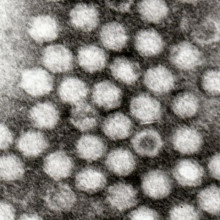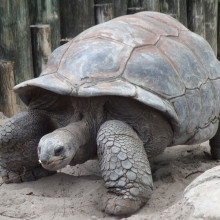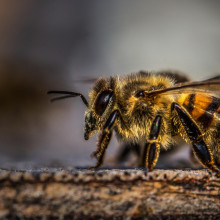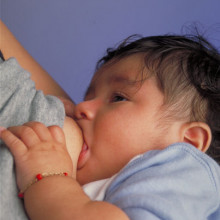Gene therapy for blindness, more efficient engines, extinct tortoises and the numeracy of bees all make an appearance in this week's Naked Scientists NewsFlash. Plus, we hear about how gold nanoparticles show antibodies travelling from breast milk to baby's blood, and a new facility in Uganda could supply affordable HIV drugs across Africa.
In this episode

01:25 - Gene therapy holds hope for blindness
Gene therapy holds hope for blindness
This week researchers have taken a step closer to using gene therapy for treating a type of inherited blindness...
Artur Cideciyan from the University of Pennsylvania led a team who have been looking at therapies that aim to treat a rare form of blindness called Leber congenital amaurosis or LCA. Studies in animals have shown that it is a mutation in a particular gene called RPE65 that causes this disease. What it does is knock out part of a process in the eye called the retinoid cycle, which regenerates vitamin A, a critical step for converting light hitting the retina into nerve signals that are sent to the brain.
By using gene therapy to replace the RPE65 gene, researchers have been able to restore the vision in animals suffering from LCA. The therapy is based on a genetically modified virus which is injected into the eye and essentially delivers a "good" version of the gene that fills in the missing link of the retinoid cycle.
And the encouraging news is Cideciyan and his team have started trying out this gene therapy on people. These are just early stage clinical trials, but they have already shown that the treatment is safe to use and can lead to moderate improvement in vision.
Three patients with LCA were injected with the treatment and, after 30 days, all three had shown improvement in their eyesight.
It seems the therapy is increasing the activity of cone cells, the parts of the eye responsible for seeing colour, by up to 50 times. And that the activity of rods, the parts responsible for night vision, could increase by 63 thousand times.
While this is encouraging news, the results of the treatment are still far from perfect. One problem was that it took the patients a very long time to get accustomed to the dark. For people with normal vision it takes less than an hour to adapt to low light levels - but in the treated patients it took them up to eight hours.
So this might not be perfect, but it already holds some hope for the development of future treatments.

04:02 - More Distance for your Diesel...
More Distance for your Diesel...
Subjecting your diesel engine to a high voltage could improve the efficiency by 20% - which could save a lot of money on the forecourt!
Internal combustion engines are becoming more efficient with each generation of cars, but we're still a long way off perfection. Now, researchers at Temple University, Philadelphia, have found a way to make diesel engines more efficient by making the droplets of fuel injected into the engine much smaller.
A diesel engine works by spraying a fine mist of fuel into a chamber, where the heating effect of pressure from a rising piston causes it to burn. In the process of burning, the fuel and its products turn into gases and expand and this expansion pushes the piston back down, powering the vehicle. The smaller the fuel droplets when they are sprayed into the chamber, the more efficiently the fuel can be burned, and the more miles you get from a tank of fuel.
Writing in the journal Energy and Fuels, Rongjia Tao and colleagues report on an electrostatic device which could be fitted to a standard engine and subjects the fuel to a strong electric field shortly before it passes into the fuel injector. This gives each droplet of fuel a negative charge and, as like charges repel, the droplets then repel one another, and form a finer mist as they are sprayed into the combustion chamber. This makes the engine much more efficient, and improves fuel mileage significantly.
In lab tests, the team achieved 20% greater power than a traditional engine for the same fuel consumption rate and in real highway driving conditions, the device increased the fuel mileage from 32 to 38 miles per gallon, an increase of 18%. Even in more demanding conditions of driving in a city, the improvement of fuel mileage averaged at 12-15%. Also, as the device consumes only 0.1w of electrical power, the improvements in efficiency are not cancelled out by a large increase in electrical consumption.
The team have shown it works well on two engines so far, and are confident that it can be adjusted to work with existing engines as well as new ones, running on diesel and petrol and even things like biodiesel, petrol mixed with ethanol or even kerosene.

06:17 - Giant tortoises not gone yet
Giant tortoises not gone yet
This week saw the return of Galapagos Day, an annual event held by the Galapagos Conservation Trust and this year there was some good news: a species of giant tortoise that was thought to have gone extinct over a hundred years ago may in fact not be lost forever...
A team of scientists from Yale University in the States have extracted traces of DNA from specimens of extinct Galapagos tortoises kept in museums, and discovered that at a species that used to live on Floreana Island was genetically distinct from all the other giant tortoises.
The results of the study published in the PNAS journal this week by Giselle Ciccone and her colleagues might not be such ground breaking news, were it not for another discovery they made among tortoises still living in Galapagos - some of the close relatives of the extinct Floreana Island tortoises are still with us.
When Darwin visited the Galapagos Islands in 1835 he was inspired by the incredible giant tortoises which can grow to up to a quarter of a tonne and live for over a century. It wasn't so much their great size that wowed him, but the fact each island seemed to have its own species of tortoise - the isolation of the islands meant that different tortoises evolved subtle differences from each other.
But sadly, their great size and lack of speed has meant that giant tortoises have suffered from human greediness, with four out of 15 species going extinct. The Floreana tortoises are thought to have gone extinct within 15 years of Darwin's visit.
What Ciccone and her team have discovered is that some of the tortoises living on Isabela island are in fact a long lost relations of the extinct Floreana species - called Geochelone elaphantopus.
What probably happened is that somehow, a few Floreana tortoises found their way to Isabela, perhaps a whaling ship left them there realizing they had more food on board than they needed. And these visiting tortoises bred with the residents producing hybrids - now some of Isabela tortoises have half Floreana genes.
This means that even though there are no living Floreana tortoises, their genes do live on and there is potential that a careful breeding programme could restore them - one day perhaps - to their former glory. It would take an extremely long time, since giant tortoises take so long to breed but in theory, the living hybrid tortoises could be bred and selected so that they only possess the original floreana genes.

09:16 - Bees can count up to 4
Bees can count up to 4
Scientists have shown that bees can count up to 4!
Marie Dacke and Mandyam Srinivasan who carried out the work at the Australian National University in Canberra have published a paper in Animal Cognition describing a series of experiments to prove that the humble honeybee is numerically more sophisticated than some humans.
In an elegant series of experiments the duo trained bees to fly along a featureless tunnel past a series of identical yellow landmarks, behind one of which was always hidden a small sugary treat.
By varying the distances between the landmarks, changing the shape and size of the landmarks, and also obscuring the landmarks sequentially so the bees could only see them one at a time, the duo have cleverly shown that the bees must be totting up how many landmarks they've passed in order to reach their intended target.
The only slight snag is that the bees can't count up to more than four! Once the team started to hide the treat behind a fifth landmark, bee performance took a nose dive.
Dacke and Srinivasan think that the insects use their counting ability to help them to navigate.
By ticking off a few landmarks along the way and combining this with an internal measure of how far they've travelled this is probably how they get from A to "Bee"!

11:05 - From Breastmilk to Baby's Blood
From Breastmilk to Baby's Blood
Pamela Bjorkman, Caltech
Ben - Now also in the news this week researchers at the Howard Hughes medical institute at Caltech have followed an antibody as it passes through the wall of the stomach. This must happen for mother to pass on immunity to a baby through breast milk. In order to see what happened they attached nano sized particles of gold to antibodies that they then fed to rats. Professor Pamela Bjorkman was leading the work and joins us now. Hi, Pamela.
Pamela - Hello
Ben - So Pamela, how did you actually do this? How did you see these antibodies passing through the stomach wall?
Pamela - Well, first we used a technique called electron tomography. Normally with electron microscopy, you take images of cells and you see their organelles. You can normally achieve nanometre resolution. So you can see membranes and other things like that. By attaching the nanogold particle to the antibody we could trace it as it was taken up by the intestinal cells. We could watch which parts of the inside of the cell it progressed as it was going across the cell.
Ben - Now, a lot of the time with these sorts of experiment people use something like a fluorescent tag which they attach to whichever chemical they are trying to follow. Would this have been possible or is it vital that you used this nano scale gold?
Pamela - A fluorescent tag wouldn't be visible in an electron microscope because what you need to see there is very electron dense particles. So the gold tags that we were using were actually 55 or 60 gold atoms that were attached. That is electron dense enough that with a little bit of an enhancement procedure we could see those. Every time we had a transport event we could visualise that by one of these gold tags. We were looking at single receptor bound to an antibody in each case. It was visible by the gold tag.
Ben - So once the antibody binds to the receptor how does it get through the cell? How does it push through?
Pamela - Well, it comes in through what is called receptor mediated endocytosis. It binds to its receptor which is on the side of the intestine it faces when milk comes into the gut. It binds there. It then goes inside to the cell, into these membranous compartments that are very strange shapes but they're tubes or they're like big spherical balls. It goes inside those and those are acidic and this receptor binds very tightly to the antibody at an acidic pH. These vesicles wander around inside the cell and then when they reach the side of the cell that faces the blood stream, which is where they eventually want to dump their cargo. These little tubules fuse with that membrane. Then they're exposed to the pH of blood which is slightly basic and at that pH the antibody rapidly falls off, enters the newborn bloodstream and the result is that it acquires its mother's antibodies.
Ben - So it's the difference in pH between inside your gut and inside your bloodstream that actually makes this a one-way process?
Pamela - Exactly.
Ben - So why is this so important, why do we need to transfer antibodies from breast milk to blood?
Pamela - It turns out that human babies don't develop fully functional immune systems until later. It's very helpful to them to have some of their mother's antibodies. It is like a path of immunisation. The mother vaccinates them with antibodies against whatever pathogens she encountered in her environment. That's directly relevant to what the baby will experience. It has been immunised by its mother.
Ben - Could this be the same mechanism through which things like HIV are transferred from mother to baby?
Pamela - HIV is transferred through breast milk but actually there is a bit of a technicality. Most of the types of antibodies that are in breast milk are not the types that are transferred by the receptor we were studying, in human breast milk anyway. We were studying the transfer of IgG antibodies. Most of the antibodies that are in human breast milk are IgA. Rodents transfer IgG through breast milk, humans transfer IgG before birth: mostly across the placenta. Much of the antibodies that humans acquire is before they are even born. It's by a transfer across the placenta. Then human foetuses swallow amniotic fluid and it is possible that they transfer maternal IgG to their bloodstream through the swallowing of this amniotic fluid that contains the mother's antibodies. I don't think that human babies actually acquire HIV through this mechanism.
Ben - Fantastic. Thank you ever so much Pamela. That was Professor Pamela Bjorkman from Caltech explaining how you can use gold or tiny particles of gold to shine a light on biological processes.
Related Content
- Previous Elderly Eyebrows
- Next Young at Heart - Healthy Ageing










Comments
Add a comment